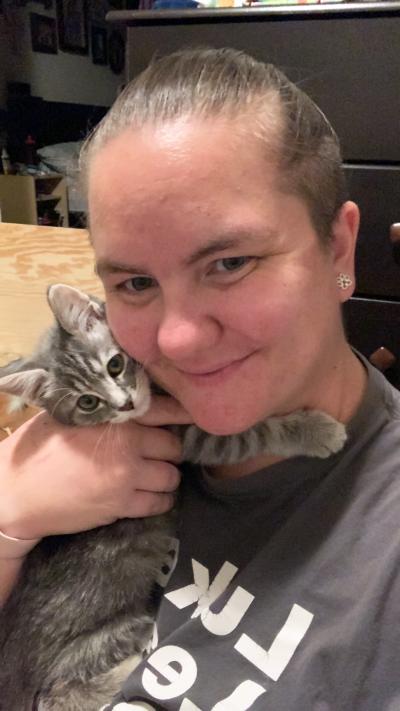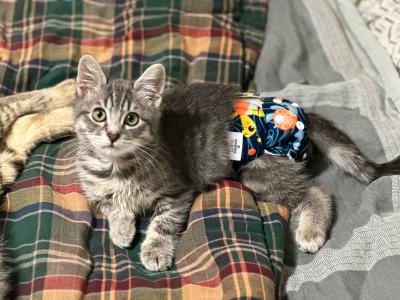Kitten seizes life on two legs

One of Benedict’s favorite ways to spend the day is by running back and forth down the hallway chasing his catnip toy. The young gray tabby cat loves climbing his scratching post and chasing his feline-in-fun, Wallaby. Never mind the fact that Benedict can’t use his hind legs. That doesn’t stop him at all.
Whenever Benedict’s adopter, Kelsi, watches him seize the moment (and occasionally the curtains) while having fun, all she sees is a kitten who’s just like others. The only difference is that Benedict was born with spina bifida, a congenital condition that affects his ability to walk on his back legs.
Sometimes, when Kelsi holds Benedict to her chest when he’s tired of taking the world by storm, she thinks back to when she first met him, how far he’s come and all the people who helped him along the way.

The why behind a kitten’s leg paralysis
When they were just a few weeks old, Benedict and his brother, Hashbrown, came to Best Friends in Utah from a West Valley Animal Services shelter. Hashbrown appeared healthy but Benedict could not walk. Instead, he got around by pulling himself with his front legs.
When the veterinary team examined Benedict, it was determined that his hind legs were paralyzed. He was also incontinent, and when anyone touched him on his back, he cried out, letting them know he was in pain. “At first, we suspected trauma,” says Dr. Megan McCarthy, the veterinarian who examined Benedict. “But we couldn't rule out a birth defect without further testing.”
Dr. Megan wasn’t surprised that X-rays of Benedict’s spine didn’t reveal much. Since Benedict was still a kitten, his bones were still growing, and that made the film hard to read. Dr. Megan then contacted one of her veterinary school classmates, Dr. Ashley Hechler (a veterinary neurologist in Park City), who suggested bringing Benedict in for a visit when he was a little older.
At that point, Benedict was still too young and small to be placed under the anesthesia required for a CT scan, which would help get to the bottom of his medical condition. In the meantime, he was prescribed medication to help manage pain, and the team started looking for a foster home for both cats.

Fostering a kitten with special needs
Kelsi Pughes, a foster volunteer with Best Friends, had been following Benedict’s journey since he arrived at the lifesaving center and had become a fan. “There was a video of Benedict walking, and I remember thinking his little waddle was adorable,” she says.
When Kelsi learned Benedict and Hashbrown needed a foster home, she paused. She’d never fostered a cat with special needs, let alone a kitten who can’t go to the bathroom on his own. Since Benedict is incontinent, it’s necessary to manually express his bladder three or four times a day.
A couple of days later, Kelsi checked back with the foster team. The two kittens still needed a foster home, and she hadn’t been able to get Benedict’s adorable waddle out of her mind. So, she asked the team if she could foster them. After receiving an enthusiastic green light, Kelsi stopped by the lifesaving center to meet the kittens and learn how to express Benedict’s bladder. That same day, she brought both of them home.
After a few days of trial and error, Kelsi got the hang of expressing Benedict’s bladder. Washable diapers helped when he dribbled a little urine. They were figuring out a routine that worked for them.

Spina bifida in kittens
A few weeks after Benedict and Hashbrown went to stay with Kelsi and her family, Hashbrown went to live with a new foster family that eventually adopted him. Kelsi could focus on helping Benedict, who was finally ready for his CT scan.
Dr. Megan and Dr. Ashley had suspected that spina bifida was the cause of Benedict’s mobility challenges and spine pain. And CT images showing that an area of his spine was missing (specifically, his fifth lumbar vertebra) confirmed their hunch.
“Spina bifida is a birth defect where the vertebrae and spinal cord do not form properly during embryonic development in utero,” explains Dr. Megan. “This leaves the spinal cord and nerves exposed.”
[Paralyzed kitten gets a custom set of wheels and a family]
In Benedict’s case, he showed many of the symptoms of spina bifida, including (to varying degrees) hind limb paralysis, incontinence and pain. Sometimes, spina bifida causes cerebrospinal fluid, which surrounds the brain and spinal cord, to leak out of the skin and cause an infection. Whoever adopted Benedict would need be aware of this, keep an eye on him and be responsible for the daily routines of giving him medicine and expressing his bladder and bowels.
While some cats with spina bifida can benefit from surgery, Dr. Megan says Benedict’s case is severe enough that surgery would likely be unsuccessful. He will remain unable to walk for the rest of his life, but Benedict has already started the next chapter of a long and wonderful life.

Feisty feline family member
After fostering Benedict for a few months, Kelsi considered adoption, but wanted to first make sure she could commit to providing him with the care he needs. “The more we got to know his personality, the less and less (helping him go to the bathroom) mattered,” she says. “He was part of our family, and (it) was just a part of his care, like feeding him or making sure he’s healthy.”
[Paralyzed cat is ‘paws-itively perfect’ and now he’s home]
“Benedict is a feisty little guy. He does not let the fact that he can’t use his back legs slow him down at all. His favorite things to do are to chase our other cat, Wallaby, play with his jingly ball and climb the cat tree.”
Kelsi loves it when she hears the pitter-patter of Benedict’s paws as he runs in his signature way after Wallaby. He’s also found a way to move Kelsi’s dog away from the food bowl so that he can eat it himself. Sure, Kelsi’s dog is bigger than Benedict. But does Benedict mind? Nope.

The benefits of having an incontinent pet
Nowadays, Kelsi is a pro at expressing Benedict’s bladder and she’ll tell you that it’s a pretty easy process. “It doesn’t take a lot of extra time to express him and get him into a clean diaper,” she says. “Not to mention, Benedict is the only cat I know who goes to the bathroom in the toilet.” The way she sees it, there’s also less time scooping the litter box since Wallaby is the only cat using it.
The fact that Benedict needs his bladder expressed is the last thing Kelsi thinks about when she looks at him. Instead, she sees a beautiful young cat with a long life filled with love ahead of him. “He has a big personality and loves to play,” she says. “But after all the play is done, he is the biggest cuddle bug. He loves to curl up in a lap and make biscuits. He is truly the sweetest.”

Give a pet a home
There are many pets around the country looking for a place to call home. Maybe that could be with you!
Read more
Life on three limbs can’t slow down this kitten